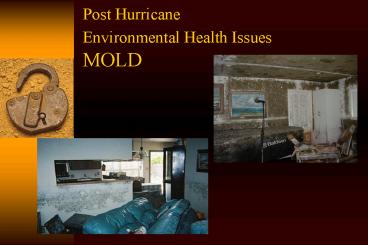Post Hurricane Environmental Health Issues MOLD - PowerPoint PPT Presentation
1 / 27
Title:
Post Hurricane Environmental Health Issues MOLD
Description:
The remnants of Hurricane Ivan passed through the ... Aspergillus sp. ... Predominant fungi indoors and outdoors were Aspergillus spp. and Penicillium spp. ... – PowerPoint PPT presentation
Number of Views:137
Avg rating:3.0/5.0
Title: Post Hurricane Environmental Health Issues MOLD
1
Post Hurricane Environmental Health Issues MOLD
2
Post-Hurricane Environmental Health Issues
- Pittsburgh has always
- experienced floods,
- many of great
- intensity.
3
Hurricane Ivan
- The remnants of Hurricane Ivan passed through the
Commonwealth on September 17th and 18th, 2004,
dropping up to nine and one-half inches of rain.
The banks of many streams overflowed, flooding
low-lying areas.
4
What is Mold?
- Molds are types of fungi.
- Mold grows indoors when mold spores come in
contact with wet areas. - You can find molds in places with water damage,
high humidity and dampness.
5
Are all molds hazardous?
- Of the thousands of types of molds, only a
relatively few have been associated with harm to
humans. These include
6
Alteraria
- Most commonly associated with Sinusitis, asthma
7
Aspergillus sp.
- Allergic bronchopulmonary aspergillosis symptoms
similar to asthma, but more chronic and severe
8
Cladosporium sp.
- Very common, especially air, decaying vegetation,
food contaminant opportunist - Uncommon human pathogen
9
Penicillium spp.
- Rare human infections symptoms would be
bronchopulmonary (pneumonia) keratitis
peritonitis - May cause problems for those allergic to
Penicillium.
10
Stachybotrys
- Most infections are associated with hay
fever-like symptoms some strains produce
mycotoxins
11
Health and Mold
12
U.S. Disease Prevalence
- 1 of 5 Americans suffer from allergic disease
- Indoor allergens responsible for significant
share.
Source NHLBI, 1991
13
Health and Mold
- Molds can produce allergens, irritants and in
some cases toxins. - Breathing or touching mold spores may cause an
allergic response in some people and worsen
breathing problems such as asthma. - Common reactions to mold are cough, congestion,
runny nose, burning eyes, headaches, sneezing and
sore throat. - Children, pregnant women, the elderly and people
with weak immune systems may be more sensitive to
mold.
14
Toxic Molds or Black Toxic Molds
- Toxic molds are those molds that produce
compounds called mycotoxins. - Mycotoxins are produced as a defense against
other microorganisms. - Black toxic mold can refer to a certain type of
moldStachybotrys chartarum (also known as
Stachybotrys atra).
15
Toxic Molds or Black Toxic Molds
- Toxic Mold - Stachybotrys
- 1994 10 cases of acute pulmonary hemosiderosis
in infants in Cleveland Stachybotrys found in
houses. - Local Health Dept conclude an association between
indoor mold and children's condition - 2000 CDC study - not enough evidence to
conclude an association between indoor mold and
childrens condition - CDC position on health effects no consensus
16
Toxic Molds or Black Toxic Molds
- Texas Medical Association Council of Scientific
Affairs - No evidence that Stachybotrys causes serious
health problems or aggravates existing health
conditions. - Houston Chronicle 22 Sept. 2002
17
Toxic Molds or Black Toxic Molds
- Stachybotrys Relevance to Human Disease
- Conclusions The current public concern for
- adverse health effects from inhalation of
- stachybotrys spores in water-damaged buildings
- is not supported by published reports in the
- medical literature.
- Annals of Allergy Asthma Immunology Vol. 87 Dec.
2001 p. 57- 63
18
Toxic Molds or Black Toxic Molds
- Fungi Toxic Killers or Unavoidable Nuisances
- Conclusions The review led to the conclusion
that - the primary effect from fungal exposure is
allergic - disease, and that the evidence for inhalation
disease resulting from mycotoxin exposure in
residential and office settings is extremely
weak. - Annals of Allergy Asthma Immunology Vol. 87 Dec.
2001 p. 57-63
19
Toxic Molds or Black Toxic Molds
- Levels of exposure in the indoor environment,
dose-response data in animals, and dose-rate
considerations suggest that delivery by the
inhalation route of a toxic dose of mycotoxins in
the indoor environment is highly unlikely at
best. - American College of Occupational and
Environmental Medicine October 2002
20
Toxic Molds or Black Toxic Molds
- Sufficient evidence for opportunistic
infections in immunocompromised persons. - Sufficient evidence for an association between
both damp indoor environments and mold and
respiratory symptoms. - Institute of Medicine. Damp indoor spaces and
health. Washington DC National Academies press
20004
21
Health Concerns Associated with Mold
- October 2005 CDC Study Health Concerns
Associated with Mold in Water-Damaged Homes After
Hurricanes Katrina and Rita --- New Orleans Area,
Louisiana. - The report found that 46 of inspected homes had
visible mold growth . - Predominant fungi indoors and outdoors were
Aspergillus spp. and Penicillium spp.
22
Health Concerns Associated with Mold
- The report concluded that, in the New Orleans
area post-hurricane, indoor environmental
conditions and personal practices provided
exposures that potentially put residents and
remediation workers at risk for negative health
effects. - No significant increases in cases of wheezing,
pneumonia or asthma attacks observed.
23
Prevention and Remediation
- When microbial contamination is found, it should
be eliminated by means that not only limit the
possibility of recurrence but also limit exposure
of occupants and persons conducting the
remediation. - Institute of Medicine. Damp indoor spaces and
health. Washington DC National Academies press
20004
24
Prevention and Remediation
- STAY ALERT FOR PROBLEMS AND BE PATIENT ABOUT
REBUILDING
25
Public Health Interventions
- Emphasize the importance of safe remediation
practices and ensure the availability of
recommended personal protective equipment.
26
Public Health Interventions
27
- Questions































